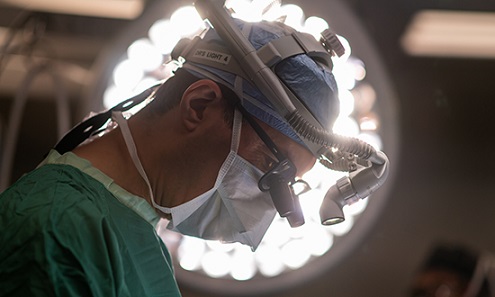Heart Care
Minimally Invasive Valve Surgery

There are four valves (aortic, mitral, tricuspid and pulmonic) that control blood flow in the heart. A diseased or damaged valve can interfere with blood flow and force the heart to work harder to send blood to the rest of the body.
At the University of Maryland St. Joseph Medical Center, our cardiac surgery team offers four types of minimally invasive valve surgeries:
- Minimally Invasive Mitral Valve Repair
- Minimally Invasive Mitral Valve Clip
- Minimally Invasive Aortic Valve Replacement
- Transcatheter Aortic Valve Replacement (TAVR)
Minimally invasive valve procedures provide many benefits for patients including:
- Shorter hospital stay
- Less pain
- Less blood transfusion
- Quicker recovery time
Minimally Invasive Mitral Valve Repair
Minimally invasive mitral valve surgery can repair (or replace) a damaged mitral valve and is approached through a small incision in your lower right chest. This operation may be needed when the valve stiffens and the opening narrows (mitral stenosis) or the leaflets do not close completely (mitral regurgitation).
Minimally Invasive Mitral Valve Clip
The mitral valve clip is a minimally invasive clip device that attaches to the leaflets of the mitral valve. This is used to treat mitral valve regurgitation. The mitral clip is inserted into a vein in the groin. From there, it is threaded through the vein and advanced from the right side to the left side of the heart. The surgeon then directs the clip to grasp the mitral valve. The entire procedure can be done with just a small hole in the groin.
Minimally Invasive Aortic Valve Replacement
Minimally invasive aortic valve surgery can replace a damaged aortic valve and is approached through a small incision in the mid-chest. This operation is needed when the valve stiffens and the opening narrows (aortic stenosis) or the leaflets do not close completely (aortic regurgitation).
Transcatheter Aortic Valve Replacement (TAVR)
TAVR surgery is performed without opening the chest. The surgeon inserts a thin, flexible wire into a blood vessel in the leg and threads it into the heart. The new valve travels over the wire and is placed inside the patient's diseased valve. A stent around the new valve anchors it in place. The new valve immediately takes over, regulating blood flow out of the heart to the rest of the body.
